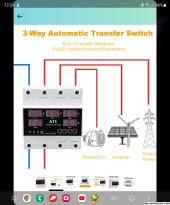Has anyone used any of these Chinese AC Automatic Transfer Switches?
I have been looking into the Geya W2R-3P.
I'm planning on using one of these, but at the moment using it as a manual bypass if I need to connect inverter output or generator to breaker panel. I don't really see what's the thickest wire (AWG) these devices hold. They say they work up to 100 amps @ 110V AC. I've messaged them, but get conflicting responses.
I have been looking into the Geya W2R-3P.
I'm planning on using one of these, but at the moment using it as a manual bypass if I need to connect inverter output or generator to breaker panel. I don't really see what's the thickest wire (AWG) these devices hold. They say they work up to 100 amps @ 110V AC. I've messaged them, but get conflicting responses.




